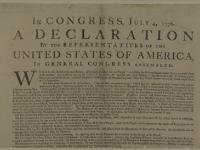On July 4th, 1776, the Second Continental Congress adopted the Declaration of Independence which proclaimed to the world that the 13 colonies would no longer be ruled by the British Crown but, instead, be independent and self-governed. This document embodies Enlightenment thinking and establishes the American political core value system that “all men are created equal,” individuals are born with certain “inalienable rights, ” and it is the job of the government to protect those rights. It also justifies that when a government fails to perform its duties and abuses its power, “it is the Right of the People to alter or to abolish it, and to institute new Government.” The Declaration of Independence is one of the most influential and widely read documents in modern world history and can be broken down into five different parts; introduction, preamble, indictments, denunciation, conclusion, and signatures. This lesson will utilize both the introduction and the preamble.
Students will explore the complex use of language and phrasing in the Declaration to infer meaning and identify ideas and values. They will start by reading the introduction and preamble and synthesizing different sections into tweeter style hashtags. The goal of this part of the lesson is to have the students wrestle with complex ideas and condense them into just a few words and demonstrate comprehension. The second part of this lesson will utilize the “John Dunlap printing of the Declaration of Independence” held in the collection at the Historical Society of Pennsylvania to reveal students ability to articulate the multipart concepts presented within the Declaration of Independence. This unique publication was based on the handwritten copy Jefferson used when he presented it to Congress and contains quotation marks around phrases Jefferson wanted to emphasize and stress. Students will be tasked to mark up a copy of the introduction and preamble to reflect how they would read it aloud and then compare it to Jefferson’s version to see if they would have expressed the ideas in the same manner.


